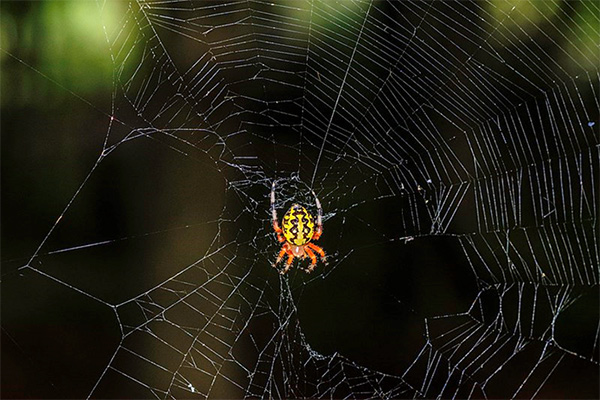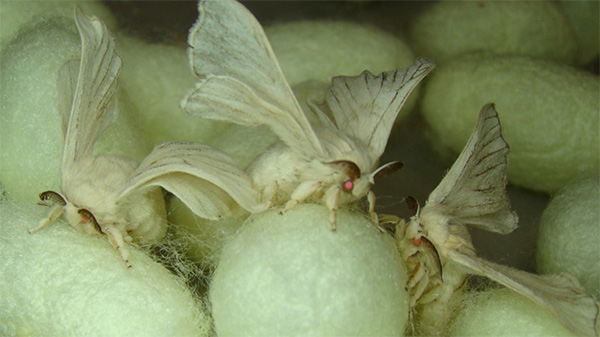
Spider silk is the strongest, most durable, most elastic fiber in the world. It’s 5 to 6 times stronger than steel by weight. A strand that could circle the globe would weigh less than a bar of soap!
Given these remarkable properties, scientists have studied it closely.
Spiders make silk with their spinnerets, tiny organs beneath their abdomens.
Before it’s spun, the silk is a gel of liquid proteins. The spinnerets remove water from the gel and extrude it through an acid bath, aligning the proteins into a solid fiber.
Each spinneret has multiple spigots. And each of those makes a single filament that the spider combines to create different silks: fine or coarse, sticky or not.
Scientists haven’t been able to re-create spider silk chemically, so they’ve enlisted another silk-spinning creature to help: the silkworm.
While spiders are almost impossible to domesticate, the silkworm has thrived in captivity for centuries. Its silk is beautiful but comparatively weak.
So scientists turned the worms into real-life Peter Parkers, giving them genes from the spider.
These genetically modified silkworms spin their cocoons as always, from a single kilometer-long strand—but this time of spider silk.
Other scientists have developed genetically modified bacteria that organize proteins similar to how spider spinnerets work.
With these developments, we may soon have fabric and other materials with the amazing properties of spider silk.
Background

Synopsis: Spiders might be scary to some, but they certainly produce amazing natural materials. Scientists are studying their silk and glue to create super-strong materials for human use.
- The more-than-45,000 species of spiders on Earth today are mostly harmless.
- Although many humans suffer from arachnophobia (an irrational fear of spiders), only about 100 deaths from spider bites were reported in the entire 20th century!
- Spiders have been around for more than 300 million years.
- The earliest spiders could produce silk that was probably used to cover eggs and the ground, and for lining holes or building trap doors for burrows.
- By about 250 million years ago, webs had evolved to trap prey on the ground and to provide protective draglines for escape.
- By about 136 million years ago, orb spiders had developed their distinctive circular webs for trapping flying insects.
- Modern spiders use silk to make webs to trap insects for food, wrap and immobilize their prey, transfer sperm, and build protective nests or cocoons. Some even recycle their webs by eating them.
- Spiders can use their silk for transportation, or ballooning (which we’ll talk about in another EarthDate episode).
- Spiders spin webs using their spinnerets, which are organs at the rear of the underside of the spider’s abdomen.
- Most spiders have six spinnerets that can move and operate either independently or together, but some spiders have two, four, or eight of the organs.
- Spinnerets don’t just produce a single thread; each has multiple spigots that produce single filaments that combine to create various types of silk.
- Spider silk is a protein fiber called gossamer, an amazing natural material that is the strongest, most durable, and most elastic natural or manmade fiber that exists.
- Spider silk is made up of complex proteins and repetitive DNA sequences.
- Before entering the spinnerets, the silk consists of a gel of liquid proteins. When the spider is ready to spin, the spinnerets remove water from the gel and extrude it through an acid bath, aligning specific proteins and instantly transforming it into a solid fiber.
- Spiders can vary both the thickness and the composition of the filaments to create sticky or nonsticky silk that is fine or coarse—whatever they need.
- Gossamer is 5–6 times stronger than steel by weight. It is even stronger than Kevlar, which is used for bulletproof vests! A strand long enough to circle the globe would weigh less than a bar of soap, and it can stretch 140 percent without breaking.
- To create manmade gossamer, material scientists have tried to solve the puzzle of how spiders create their silk—but the very fast process has proven elusive.
- Scientists sprayed spiders and their environments with graphene mixtures so the spiders would ingest the high-strength carbon material.
- These spiders then produced graphene-enhanced gossamer with up to three times the strength and ten times the toughness of normal spider silk.
- To produce faux spider gossamer in the laboratory, other scientists have developed genetically modified bacteria that organize proteins similar to the way spider spinnerets work.
- Spider glue, a hydrogel that is one of the most effective natural glues in humid conditions, is also interesting to scientists.
- Most glues and paint separate in moist conditions because of interfacial water, which gets between the glue and the surface it is meant to stick to.
- But spider glue, located on the outside of spider silk, sticks to wet surfaces. Scientists have just figured out that the glue has water-absorbing compounds that pull interfacial water away from the surface so the sticky glycoproteins can adhere to it.
- While spiders are virtually impossible to domesticate, silkworms have been farmed for their silk for centuries. Silkworm silk is beautiful but weaker than spider silk.
- Scientists have developed transgenic silkworms, which are genetically engineered to produce spider silk instead of silkworm silk.
- Per a usual life cycle, transgenic silk moths lay their eggs, eggs hatch, larvae feed on mulberry leaves, and silkworms spin cocoons made of continuous threads a half-mile long—but the threads are made of spider silk, which is harvested for use in textiles.
- These silk moths are also genetically marked with red eyes so they can be identified.

